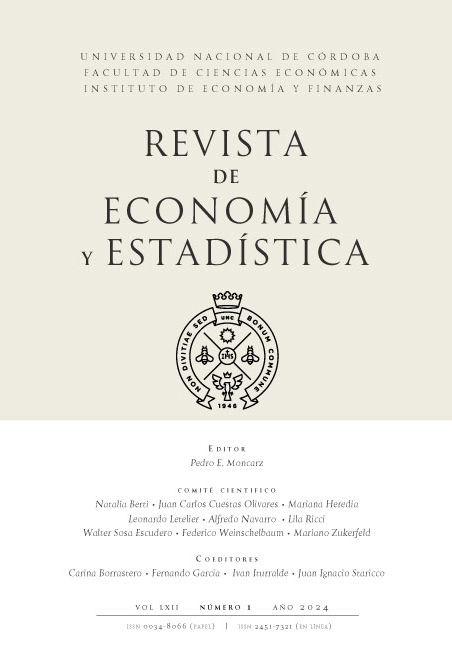Estimation of inflation compensation in the Argentine bond yield curve
DOI:
https://doi.org/10.55444/2451.7321.2024.v62.n1.44617Keywords:
Break-even inflation, Nelson-Siegel-Svensson model, Yield curveAbstract
The measurement of inflation expectations is highly relevant for an inflationary economy like Argentina's. This paper estimates the implicit inflation compensation in the yields of Argentine bonds during the inflation targeting period, using the difference between the yields of inflation-adjusted and non-inflation-adjusted Argentine bonds. Under certain conditions, this compensation is an observable measure of inflation expectations with daily frequency. There is high volatility in the compensation in the first half of 2017 and 2018. The compensation systematically registers values higher than the inflation expectations obtained by the BCRA through the market expectations survey (REM). This could suggest the impact of a premium for risk and liquidity, or indicate a possible underestimation of expectations by the REM. At the same time, the estimated compensation is a better predictor of actual inflation than the inflation expected in the REM.
Reception date: 29/03/2024
Acceptance date: 09/09/2024
Downloads
References
Banco Central de la República Argentina. (2021). Errores de pronóstico del Relevamiento de Expectativas de Mercado (REM) https://www.bcra.gob.ar/Pdfs/PublicacionesEstadisticas/Errores de pronostico del REM.pdf
Banco Central Europeo. (2004). Extracting Information from Financial Asset Prices. Monthly Bulletin, pp. 65-75.
Banco Central de la República Argentina. (2023). Relevamiento de Expectativas de Mercado. https://www.bcra.gob.ar/PublicacionesEstadisticas/Relevamiento_Expectativas_de_Mercado.asp
Brealey, R. A., Myers, S. C., y Allen, F. (2010). Principios de Finanzas Corporativas. (9. ed.). McGrawHill /Interamericana Editores, S.A. DE C.V.
Cachanosky, N., y Ferrelli Mazza, F. J. (2019). Why did inflation targeting fail in Argentina? AIER Sound Money Project Working Paper No. 2019-14.
Cavallo, A. (2013). Online and official price indexes: Measuring Argentina’s inflation. Journal of Monetary Economics, 60(2), 152-165.
Coremberg, A. (2017). Argentina Was Not the Productivity and Economic Growth Champion of Latin America. International Productivity Monitor, No. 33, 77-90.
Coroneo, L., Ken, N., y Vidova-Koleva, R. (2008). How arbitrage-free is the Nelson-Siegel model?. European Central Bank. Working Paper Series, No. 74.
Corso, E. A., y Matarrelli, C. (2019). Expectativas de Inflación Implícitas en la Curva de Rendimientos. Argentina 2017-2018. Nota Técnica BCRA, No. 3, 1-5.
Cox, J. C., Ingersoll, J. E., y Ross, S. A. (1985). A Theory of the Term Structure of Interest Rates. Econometrica, 53(2), 385-407.
Deacon, M., y Derry, A. (1994). Estimating market interest rate and inflation expectations from the prices of UK government bonds. Bank of England Quarterly Bulletin, August, 232-240.
Espinosa Torres, J. A., Melo Velandia, L. F., y Moreno Gutiérrez, J. F. (2017). Expectativas de inflación, prima de riesgo inflacionario y prima de liquidez: una descomposición del break-even inflation para los bonos del Gobierno colombiano. Desarrollo y Sociedad, 78, 315-365.
Fisher, I. y Brown H. G. (1911). The Purchasing Power of Money: Its Determination and Relation to Credit, Interest, and Crises. Macmillan.
Galí, J. (2018). The State of New Keynesian Economics: A Partial Assessment. Journal of Economic Perspectives, 32(3), 87-112.
Gilli, M., Große, S., y Schumann, E. (2010). Calibrating the Nelson–Siegel–Svensson model. COMISEF Working Paper Series, No. 031.
Gilli, M., Maringer, D., y Schumann, E. (2019). Numerical Methods and Optimization in Finance. (2. ed.). Academic Press.
Gürkaynak, R. S., Sack, B. y Wright, J. H. (2010). The TIPS Yield Curve and Inflation Compensation. American Economic Journal: Macroeconomics, 2(1), 70- 92.
Meier, K. (2019). Estimación de la estructura a término de tasas de interés en Argentina mediante el modelo de Nelson y Siegel dinámico con factores macroeconómicos. Buenos Aires: Universidad de San Andrés, Escuela de Negocios.
Mishkin, F. S. (2008). Moneda, banca y mercados financieros. (8. ed.) Pearson Educación.
Organization for Economic Cooperation and Development. (2019). Assessment of the Statistical System of Argentina and Key Statistics of Argentina.
Pereda, J. (2009). Estimación de la curva de rendimiento para el Perú y su uso para el análisis monetario. Monetaria, 32(3), 413-443.
Schumann, E. (2011). Fitting the Nelson–Siegel–Svensson model with differential evolution.
Sturzenegger, F. (2019). Macri's Macro: The Elusive Road to Stability and Growth. Brookings Papers on Economic Activity, 339-436.
Svensson, L. E. O. (1994). Estimating and interpreting forward interest rates: Sweden 1992-1994. National Bureau of Economic Research, Working paper No. 4871.
Temperley, P. J. (2024). La medición de las expectativas de inflación en Argentina: Consultoras económicas versus mercados financieros. Universidad Torcuato Di Tella.
Veronesi, P. (2016). Handbook of Fixed‐Income Securities. John Wiley & Sons, Inc.
Downloads
Published
Issue
Section
License
Copyright (c) 2024 Sebastián Román , Emiliano Carlevaro, Martín Dutto

This work is licensed under a Creative Commons Attribution-NonCommercial-NoDerivatives 4.0 International License.
Authors who have publications with this journal agree to the following terms:
Authors retain their copyright and grant the journal the right of first publication of their work, which is simultaneously subject to the Creative Commons Attribution-NonCommercial-NoDerivatives 4.0 International License that allows third parties to share the work provided that its author and first publication in this journal are indicated.
Authors may adopt other non-exclusive licensing arrangements for distribution of the published version of the work (e.g. depositing it in an institutional telematic archive or publishing it in a monographic volume) as long as the initial publication in this journal is indicated.
Authors are allowed and encouraged to disseminate their work via the Internet (e.g. in institutional telematic archives or on their website) before and during the submission process, which can lead to interesting exchanges and increase citations of the published work. (See The Open Access Effect)














